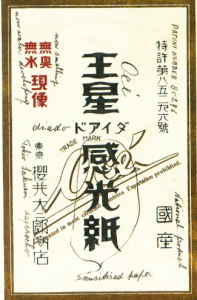The Japanese connection – presence of Océ in Japan
Océ’s relationship with Japan has a long history, which began with an adventurous journey by Karel van de Grinten to the Far East in 1934 and ended with Canon Inc. acquisition of the company in 2009-2012.
In the summer of 1934 Karel van der Grinten left for Japan. The van der Grinten brothers had thought that ‘Japan and China were very important countries for reproduction purposes in connection with their type of writing. To copy something in that script, by hand or with a typewriter, was an awful lot of work.’
And Karel would also use the trip to see what was going on in the reproduction industry at all intermediate stops along the way’. He did business in Athens, Jerusalem, Calcutta and Rangoon (Yangon), and also made numerous touristic stops.
In Japan, he visited the family business of Sakurai and entered into an agreement for the distribution of Océ products. And with Shiro Sakurai, who also spoke a little English, he struck up a lasting friendship.

Karel van der Grinten with the family Sakurai
For the demonstrations of his products, Karel needed chemicals to prepare paper suitable for the diazo printing machines he wanted to sell. He then went with Shiro Sakurai to a paper manufacturer, but there was considerable disagreement. Océ van der Grinten’s paper needed a certain degree of acidity. The director refused to make that, because that would affect his machines. “A little more acid, what harm can that do?” exclaimed Karel.
Thanks to Shiro’s mediation, the director of the paper manufacturer was convinced.
Karel was very impressed by ‘what kind of culture was behind [the Japanese] way of life’. And so “some of my self-confidence was lost. I felt that when we were still walking around here with bear skins, they were already a cultivated people. They had values that they held up that I didn’t really know about, like meditation and things like that. I wanted to incorporate those values. Yes, I’ve been refined there.’
What also made an ‘untold impression’ on Karel in those weeks in Tokyo was the ingenuity of the Japanese. To see if the Océ paper had a certain humidity level, they used a scale in the Netherlands that they did not have in Japan. But fortunately Karel had a brochure with him of such a scale. ‘I showed them what it looked like. It was a very simple picture, really just a sketch. In one night, they made that scale and it also worked.’
As early as 1934, Karel van der Grinten predicted on his return from Japan that this country would be a major factor in business in the future.
The cooperation with Sakurai continued in a satisfactory manner after Karel’s visit. Sakurai sold Océ materials and over time showed great interest in the Rétocé products, which they also wanted to manufacture themselves.

Océ label materiaal, 1934. Translations have been added in pen.
But due to the start of World War II, contacts with the Sakurai company were diminished, and only after a few decades Océ began to expand its activities in Japan, through other representatives. This led ultimately to its own branch organization; Océ Japan Corporation.
Source: Partially taken from Ron Kosterman; Elsevier Weekblad; 2014 Ed. 70; Nr. 3
